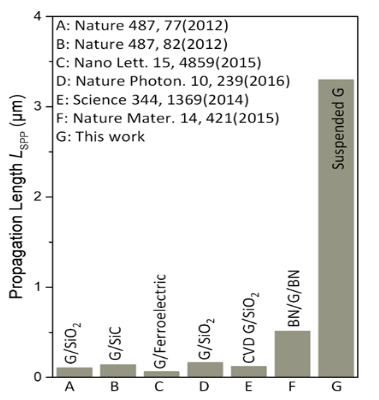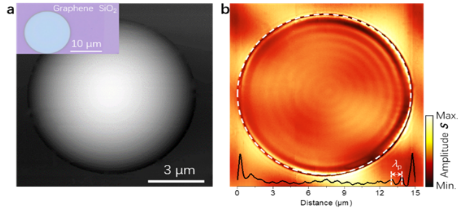
Share
Announcement/2023-11-20
Recently, Qing Dai's research team at the National Center for Nanoscience (NCNSC), in collaboration with Prof. Javier García de Abajo of the Institute of Photonic Sciences (ICFO), Spain; Prof. Mengkun Liu of the State University of New York at Stony Brook

Isoexcitation is a type of polarized excitation, which is an electromagnetic mode of mixed resonance of photons and electrons propagating along the surface of a material excited by incident light, and a unique physical phenomenon existing in nanophotonic materials. It is capable of breaking through the diffraction limit, thus promising nanoscale in-sheet interconnections. Compared with traditional metallic materials such as gold and silver, the new two-dimensional material graphene is characterized by the thickness of a single atomic layer, Dirac electronic properties and high carrier mobility, and its supported equipartitioned excitations have the advantages of higher wavelength compression ratio and electrostatic tunability, thus becoming a hot spot of research in recent years. Since the first experimental observation in 2011, graphene equipartitioned excitons have demonstrated great potential for applications in the direction of nano-waveguides, electrically tunable lasers and molecular sensors.
However, the characteristics of graphene's two-dimensional material make it exceptionally sensitive to the surrounding dielectric environment, and a number of factors have affected its transmission performance, hindering its further application in optoelectronic integrated devices. It has been shown that in addition to its own thermal phonon scattering, impurities in the substrate, aggregated charge scattering, phonon scattering, and polarization of the dielectric environment can all cause losses to graphene's equipartitioned excitations, decreasing its quality factor and transmission distance. How to break through the limitations of the dielectric environment on the performance of discrete excitons and achieve high-quality, long-transport performance of graphene discrete excitons has become a key issue that needs to be urgently solved in the development of graphene discrete excitons towards functionalized applications.

Fig. 1. Comparison of the transmission distances of graphene equipartition excitations on different dielectric substrates reported in the literature and the suspended structure of the present work.
Recently, Qing Dai's research team at the National Center for Nanoscience (NCNS), in collaboration with Prof. Javier García de Abajo at the Institute of Photonic Sciences (ICFO), Spain; Prof. Mengkun Liu at the State University of New York at Stony Brook (SUNY Stonybrook), U.S.; Prof. Zhipei Sun at the University of Aalto, Finland; Prof. Jianing Chen at the Institute of Physics, Chinese Academy of Sciences (CAS); and Prof. Pablo Alonso-González at the University of Oviedo, Spain. ález and other teams collaborated to further obtain high-quality intrinsic equipartitioned excitations in the suspended graphene structure, solving the problems of extra loss and limiting modulation introduced by the substrate.
It is found that the suspended graphene provides a pure environment for the equipartitioned excitons with a quality factor of up to 33, corresponding to a transmission distance of more than 3 μm. This is the highest transmission performance recorded for graphene equipartitioned excitons reported so far at room temperature, and it is more than one order of magnitude improvement over the performance of graphene equipartitioned excitations on silicon oxide substrates under the same conditions. In addition, this work finds that the overhang height can be used as a novel means of in situ modulation of the isoexciton, which can significantly modulate the performance of the isoexciton in terms of wavelength, transmission distance, and group/phase velocity. The team utilized this modulation advantage to develop a new type of iso-exciton switching device with an electromagnetic energy flow switching ratio of up to 14. Thanks to the electrically tunable nature of graphene, this new type of iso-exciton switching can also be modulated by gate voltage. Suspended graphene isoexcitons combine the excellent properties of long transmission distance, high tunability and controllable energy transfer, which provide a good basis for their many future applications in information photonic devices.

Fig. 2. (a) Height map of AFM imaging of 15 µm diameter suspended graphene. The inset in the upper left corner is the corresponding optical microscope photograph. (b) Near-field optical imaging image of graphene suspended over a circular hole. The concentric ripples reflect information about the amplitude of the transmitted equipartitional excitonic electric field.
The suspended structure also provides a new platform for studying polarized excitons supported by other van der Waals materials, such as phonon polarized waves, exciton polarized waves, and magnetically polarized waves. The study of the fundamental properties of the suspended two-dimensional materials enriched with polarized excitons and the tuning law of the usage performance not only avoids the various scattering and polarization effects of the substrate, thus maintaining its intrinsic physical properties and high-quality transmission performance, but also provides new ideas and choices for the future construction of novel nanophotonics devices.

Fig. 3. (a) Schematic of the suspended graphene iso-excited energy flow switching device. (b) In-situ modulation of the overhang height of graphene under different gas pressures. (c) Transmission electric field distribution of the isoexciton at different suspension heights. (d) Energy flow switching ratio of the equipartitioned exciton through the suspended interface.
This work was published on March 18, 2022 in the journal Nature Communications (Nature communications (2022) 13:1465). Associate researcher Hai Hu of the National Center for Nanoscience is the first author and one of the corresponding authors of the article, and researcher Qing Dai of the National Center for Nanoscience is the co-corresponding author along with Prof. Javier García de Abajo of the Institute of Photonics Science, Spain. We thank the Nanofab Lab @ NCNST of the National Center for Nanoscience (NCNST) for help and advice on sample preparation. The above research work was supported by the National Key Program for R&D in Nanotechnology, the National Natural Science Foundation of China, the Talent Program of the Chinese Academy of Sciences (CAS), and the Strategic Pilot Science and Technology Special Project Category B of CAS.
Original link: https://www.nature.com/articles/s41467-022-28786-8.